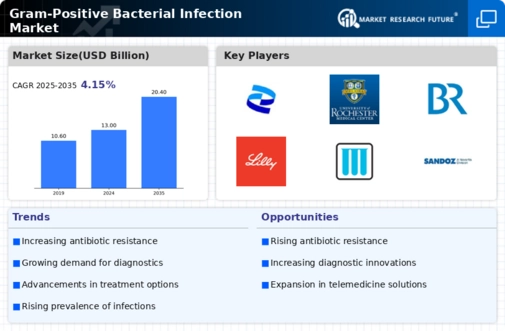Regulatory Support for New Antibiotics
The Gram-Positive Bacterial Infection Market is likely to benefit from increased regulatory support for the development and approval of new antibiotics. Regulatory agencies are recognizing the urgent need for novel antimicrobial agents to address the rising threat of antibiotic resistance. Initiatives such as the Generating Antibiotic Incentives Now (GAIN) Act in the United States aim to expedite the approval process for new antibiotics targeting resistant Gram-positive bacteria. This regulatory environment encourages pharmaceutical companies to invest in the development of innovative therapies, which could lead to a more robust pipeline of products in the Gram-Positive Bacterial Infection Market. As new antibiotics enter the market, they are expected to provide healthcare providers with additional tools to effectively manage infections, thereby enhancing patient care.
Rising Incidence of Gram-Positive Infections
The Gram-Positive Bacterial Infection Market is experiencing a notable increase in the incidence of infections caused by Gram-positive bacteria, such as Staphylococcus aureus and Streptococcus pneumoniae. This rise is attributed to various factors, including an aging population and the prevalence of chronic diseases that compromise immune systems. According to recent data, infections caused by these bacteria account for a significant percentage of healthcare-associated infections, leading to increased hospitalizations and healthcare costs. As a result, healthcare providers are compelled to invest in effective treatment options and diagnostic tools, thereby driving growth in the Gram-Positive Bacterial Infection Market. The demand for innovative therapies and rapid diagnostic tests is likely to escalate as the burden of these infections continues to rise.
Technological Advancements in Treatment Options
The Gram-Positive Bacterial Infection Market is witnessing a surge in technological advancements that enhance treatment options for Gram-positive bacterial infections. The development of novel antibiotics, such as ceftaroline and dalbavancin, has shown promise in treating resistant strains of bacteria. Furthermore, the introduction of combination therapies and targeted therapies is expected to improve patient outcomes significantly. Market data indicates that the antibiotic segment is projected to grow at a compound annual growth rate (CAGR) of over 5% in the coming years. These advancements not only provide healthcare professionals with more effective tools to combat infections but also stimulate research and development efforts within the Gram-Positive Bacterial Infection Market, fostering a competitive landscape that prioritizes innovation.
Growing Awareness of Infection Control Practices
The Gram-Positive Bacterial Infection Market is benefiting from a growing awareness of infection control practices among healthcare professionals and the general public. Educational initiatives and campaigns aimed at promoting hygiene and preventive measures are becoming increasingly prevalent. This heightened awareness is likely to lead to a reduction in the transmission of Gram-positive bacterial infections, thereby influencing market dynamics. Data suggests that healthcare facilities implementing stringent infection control protocols have reported a decrease in infection rates, which in turn drives demand for related products and services. As healthcare systems prioritize patient safety and quality of care, the Gram-Positive Bacterial Infection Market is expected to expand, with a focus on preventive strategies and effective management of infections.
Increase in Research and Development Investments
The Gram-Positive Bacterial Infection Market is experiencing a significant increase in research and development investments aimed at understanding and combating Gram-positive bacterial infections. Pharmaceutical companies and research institutions are allocating substantial resources to explore novel therapeutic approaches, including immunotherapies and bacteriophage therapy. This trend is supported by government grants and funding initiatives that encourage innovation in infectious disease research. Market analysis indicates that R&D spending in this sector is projected to rise, potentially exceeding USD 1 billion by 2027. Such investments not only enhance the understanding of Gram-positive bacteria but also pave the way for the development of new treatment modalities, thereby driving growth within the Gram-Positive Bacterial Infection Market.

















Leave a Comment